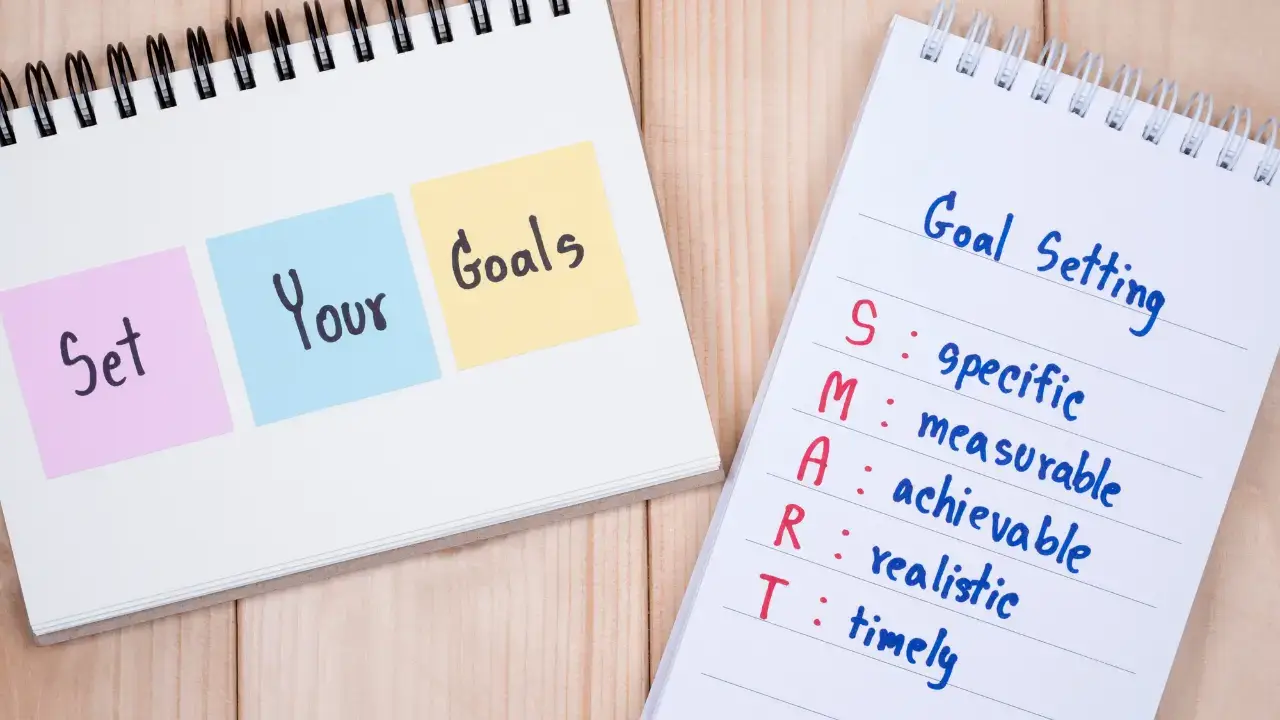Do you ever feel like you’re going through the motions but not quite reaching your full potential? You’re not alone. Many people struggle with setting goals, which is the foundation for success in any area of life.

Why Goal Setting Matters?
Psychologist and author Brian Tracy famously said, «If you fail to plan, you are planning to fail.» This rings true for goal setting. Studies show that people who set goals are significantly more likely to achieve them than those who don’t. Setting goals gives your life direction and motivates you to take action.
Here’s how effective goal setting can benefit you:
- Enhanced Motivation: Having a goal in mind gives you a reason to push forward, even when things get tough.
- Improved Decision Making: Goals act as a compass, guiding your choices and ensuring they align with your overall aspirations.
- Greater Sense of Accomplishment: Reaching your goals fosters a sense of pride and accomplishment, boosting your confidence.
Crafting Your Goal-Setting Plan
The good news is, that you don’t need a fancy app or complicated system to set effective goals. Here’s a practical framework you can use to get started:
Identify Your Focus Areas:
Start by reflecting on the major areas of your life: work, relationships, personal development, health, etc. Within each area, brainstorm potential goals you’d like to achieve.
Example: Perhaps you want to advance your career (work), strengthen your bond with your spouse (relationships), or finally master that foreign language you’ve always wanted to learn (personal development).
Make it Smart:
It’s important to understand the concept of SMART goals. SMART is an acronym that stands for Specific, Measurable, Achievable, Relevant, and Time-Bound. SMART goals provide a framework for setting goals that are clear, actionable, and realistic.
Once you have a list of potential goals, refine them using the SMART criteria:
- Specific: Vague goals lack direction. Instead of saying «get in shape,» aim for «lose 15 pounds by June 1st.»
- Measurable: Track your progress and stay motivated by setting measurable goals.
- Achievable: While you want to challenge yourself, set goals that are realistic and achievable within a specific timeframe.
- Relevant: Ensure your goals align with your overall values and aspirations.
- Time-Bound: Assign a deadline to create a sense of urgency and keep yourself accountable.

Break it Down
Large, overwhelming goals can be paralyzing. Break down your main goal into smaller, actionable steps.
Example: Your goal might be to launch your own online business (work). This can be broken down into smaller steps like market research, competitor analysis, product development, and website creation.
Plan and Track:
Now that you have a roadmap, schedule specific tasks and milestones into your calendar. There are numerous goal-setting apps available to help you manage your plan and track progress for example:
Celebrate Wins and Adapt
Reaching milestones, big or small, deserves recognition! Celebrate your accomplishments to stay motivated. Remember, life throws curveballs. Be prepared to adapt your goals and action steps as needed.
Goal Setting for Businesses and Teams.
Goal setting isn’t just for individuals; it’s a powerful tool for businesses and teams as well. Frameworks like OKRs (Objectives and Key Results) help organizations establish clear, measurable goals and track progress at all levels.
Specific goals are well-defined and focused. They answer the questions of what needs to be accomplished, why it is important, who is involved, and where it will take place. Measurable goals have clear criteria for success, allowing progress to be tracked and evaluated. Achievable goals are realistic and attainable, considering the available resources and capabilities of the team. Relevant goals align with the overall objectives of the team and contribute to its success. Time-bound goals have a specific deadline
Achieving team performance goals is crucial for the success of any organization. However, setting meaningful and achievable goals can be a challenge. Incorporating a mix of individual and group activities.
The importance of goal setting in team performance
Setting clear goals is essential for team performance because it provides direction and purpose. Without goals, teams can become disorganized, inefficient, and lack motivation. When goals are well-defined, teams have a shared vision and a common understanding of what needs to be achieved. This shared vision fosters collaboration and ensures that everyone is working towards the same objectives.
Goal setting also helps teams prioritize their efforts and allocate resources effectively. By identifying the most important goals, teams can focus their energy on the tasks that will have the greatest impact on their success. This prevents teams from getting overwhelmed or distracted by less important activities.
Furthermore, goal setting promotes accountability within the team. When goals are clearly defined, it becomes easier to measure progress and evaluate performance. This accountability encourages team members to take ownership of their responsibilities and work together towards achieving the desired outcomes.
Goal setting is a continuous process, not a one-time event. The key is to find a system that works for you and refine it as needed. Remember, there’s no such thing as a perfect goal-setting plan. The most important thing is to take action and move forward.
Specific goals are well-defined and focused. They answer the questions of what needs to be accomplished, why it is important, who is involved, and where it will take place. Measurable goals have clear criteria for success, allowing progress to be tracked and evaluated. Achievable goals are realistic and attainable, considering the available resources and capabilities of the team. Relevant goals align with the overall objectives of the team and contribute to its success. Time-bound goals have a specific deadline or timeline, providing a sense of urgency and ensuring that progress is made within a specific timeframe.
By setting SMART goals, teams can ensure that their objectives are meaningful, actionable, and achievable. This sets the foundation for the goal-setting exercises that will follow, allowing teams to create goals that are aligned with their vision and have a clear roadmap for success.
5 Powerful Goal Setting Exercises to Supercharge Team Performance
Exercise 1: Vision board creation
To create a vision board, gather the team together and provide them with materials such as magazines, scissors, glue, and poster boards. Ask each team member to find images, words, and phrases that represent their individual goals and aspirations. They can cut these out and arrange them on the poster board, creating a collage that reflects their collective vision.
Once the vision boards are complete, encourage team members to share their boards with each other. This will foster open communication and allow team members to gain insights into each other’s goals and aspirations. It will also help identify common themes and areas of alignment, which can be used to refine and consolidate the team’s goals.
The vision boards should be displayed in a prominent place where team members can see them regularly. This will serve as a constant reminder of the team’s goals and keep everyone focused and motivated.
Exercise 2: Team goal brainstorming session
The second exercise is a team goal brainstorming session. This exercise encourages collaboration and creativity, allowing team members to generate a wide range of ideas and possibilities.
Start by gathering the team in a brainstorming session. Provide them with a whiteboard or a flip chart and ask them to write down their ideas for team goals. Encourage everyone to contribute and think outside the box. The goal is to generate as many ideas as possible without any judgment or evaluation.
Once the brainstorming session is complete, review the list of ideas together as a team. Identify the goals that align with the team’s vision and objectives. Discuss the feasibility and relevance of each goal, considering the available resources and capabilities of the team.
Narrow down the list to a set of goals that are specific, measurable, achievable, relevant, and time-bound. It’s important to prioritize the goals based on their importance and potential impact on the team’s success. This will ensure that the team’s efforts are focused on the most critical objectives.
Exercise 3: Individual goal setting with accountability partners
The third exercise focuses on individual goal setting with accountability partners. This exercise promotes personal growth and development, while also fostering a sense of responsibility and support within the team.
Start by pairing team members with an accountability partner. The accountability partner will act as a support system and provide feedback and encouragement throughout the goal-setting process.
Ask each team member to identify their individual goals based on the team’s overall objectives. These goals should be aligned with the team’s vision and contribute to its success. Each team member should also define specific actions and milestones that will help them achieve their goals.
Once the goals are defined, the team members should share them with their accountability partner. This will create a sense of commitment and ensure that the goals are communicated and understood.
The accountability partners should meet regularly to discuss progress, provide feedback, and offer support. This will help team members stay motivated and accountable for their goals. It also provides an opportunity for collaboration and learning, as accountability partners can share insights and experiences.
Exercise 4: Tracking progress with OKRs (Objectives and Key Results
The fourth exercise involves tracking progress with OKRs (Objectives and Key Results). OKRs are a goal-setting framework that helps teams define and track their objectives and the key results that will indicate success.
Start by defining the team’s objectives. These should be specific and aligned with the team’s vision and goals. Each objective should have associated key results that define the metrics or milestones that will indicate progress towards the objective.
Once the objectives and key results are defined, track progress regularly. This can be done through regular check-ins, progress reports, or dedicated software tools. The key is to regularly evaluate progress and make necessary adjustments to stay on track.
OKRs provide a clear and measurable framework for tracking progress and ensuring accountability within the team. By regularly reviewing and evaluating progress, teams can identify areas of improvement and make necessary adjustments to their goals and strategies.
Exercise 5: Reflecting and adjusting goals for continuous improvement
The final exercise focuses on reflecting and adjusting goals for continuous improvement. Goal setting is not a one-time activity, but an ongoing process that requires regular evaluation and adjustment.
Encourage the team to regularly reflect on their goals and progress. This can be done through team meetings, individual reflections, or surveys. Ask team members to evaluate the effectiveness of their goals and identify areas for improvement.
Based on the reflections, adjust the goals as needed. This may involve refining the goals, modifying the key results, or even setting new goals altogether. The key is to ensure that the goals remain relevant, challenging, and aligned with the team’s vision and objectives.
Regular reflection and adjustment of goals promote continuous improvement and adaptability within the team. It allows teams to stay agile and responsive to changing circumstances, ensuring that their goals remain achievable and meaningful.
Setting meaningful and achievable goals is crucial for team performance. By incorporating these 5 powerful goal-setting exercises, teams can enhance their clarity, alignment, and accountability. From creating a shared vision to setting measurable objectives, these exercises provide a structured approach to goal setting that is both engaging and effective.
Through collaboration, communication, and a sense of ownership, teams can define their goals, create a roadmap for success, and drive continuous improvement. By regularly reviewing progress and adjusting goals as needed, teams can stay on track and overcome challenges along the way.
So, whether you’re striving for greater productivity, improved communication, or enhanced problem-solving skills, these 5 powerful goal-setting exercises will help your team unlock their full potential and drive success.
My Virtual Partnr has helped Owner businesses and entrepreneurs of different kinds of sectors and industries(E-Commerce, Writers, Coaches, Marketing Agencies). to set their goals.

